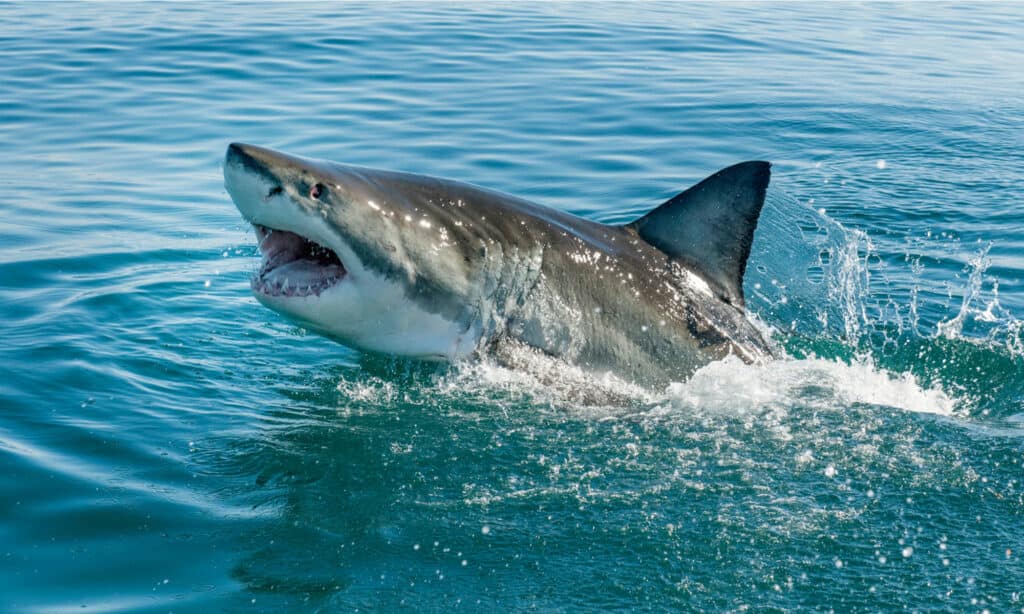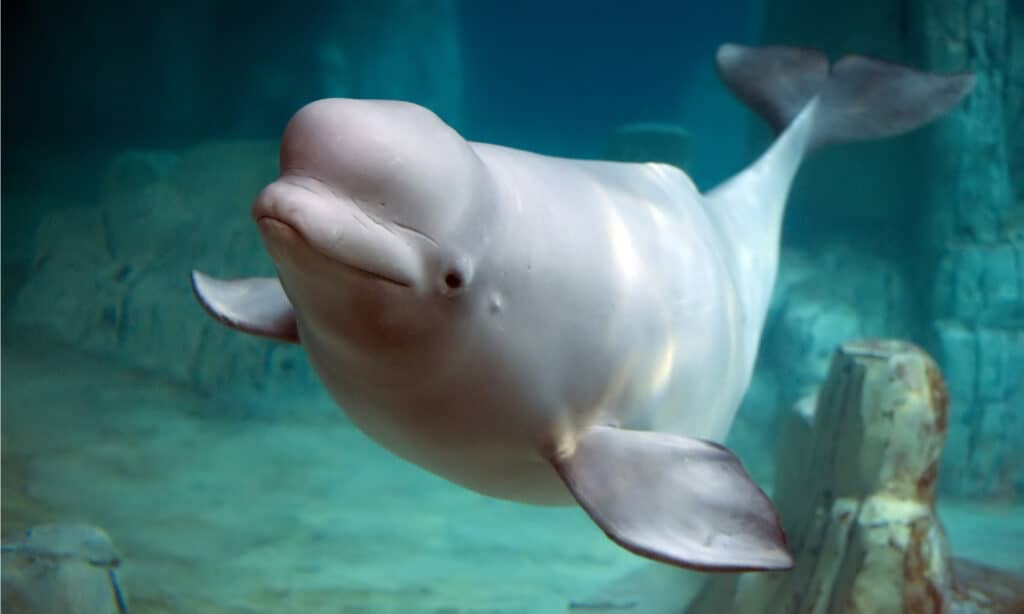A dorsal fin is a type of fin present on the backs of most types of aquatic (both freshwater and marine) vertebrate animals, most notably fish and aquatic mammals like whales and dolphins. A fin is a thin, often somewhat flexible appendage attached to a larger part of an animal’s body.
Summary

Most known varieties of
sharks
have a pair of dorsal fins, the larger of which is typically located in the middle of the back. This
great white shark’s
frontal dorsal fin is visible above, while its rear dorsal fin remains submerged.
©Jayaprasanna T.L/Shutterstock.com
Though dorsal fins are best understood in fish, they are also present in aquatic mammals like dolphins, whales, and porpoises. Additionally, many extinct species of prehistoric marine reptiles had dorsal fins, most notably certain mosasaurs, ichthyosaurs, and plesiosaurs. Most animals have a single dorsal fin, while others can have pairs. Certain types of fish can have up to three dorsal fins.
Some animals’ dorsal fins are supported by thin bones. However, others, as is the case for most sharks and cartilaginous fishes, lack actual bony bones entirely and instead get their support from cartilaginous bones. The bones and/or cartilage at the base of a dorsal fin are known as pterygiophores. These help support and hold up the dorsal fin(s) and give them their shape.
Dorsal fins can have a wide range of shapes and sizes depending on an animal’s overall body plan, size, lifestyle, and environment. In general, dorsal fins help provide stability for an animal as it swims, though some animals’ dorsal fins have evolved and adapted over time to suit other purposes.
Notably, dorsal fins also serve an important purpose in wildlife research. As every animal’s dorsal fin develops its own distinctive markings and scarring over time, they can be used to identify specific animals in the wild.
Animals With Dorsal Fins

Many species of whales such as the
orca
(or, alternatively, the killer whale) have a single prominent dorsal fin. However, certain varieties such as the beluga whale and narwhal lack this dorsal fin entirely.
©Tory Kallman/Shutterstock.com
Many types of aquatic animals have prominent dorsal fins, including the majority of known bony and cartilaginous fishes. Many aquatic mammals like whales, dolphins, and porpoises also possess dorsal fins. As detailed above, animals can have up to three dorsal fins, though many have just one or two.
How Dorsal Fins Function

This great white shark’s first dorsal fin and caudal fin are visible above. Its second, smaller dorsal fin is located between the first dorsal and caudal fin and is submerged here.
©iStock.com/Alessandro De Maddalena
The primary function of a dorsal fin is to provide an animal with additional stability while swimming. Specifically, a dorsal fin or fins can assist an aquatic animal with turning or prevent it from rolling, especially against strong ocean or freshwater currents.
However, depending on an animal’s environment and lifestyle, the dorsal fins can serve other unique purposes. In particular, many types of marine fish have heavily modified dorsal fins. In the anglerfish, for instance, the back of its dorsal fin has evolved to mainly serve as a long, thin lure with a soft, fleshy tip to attract prey.
Alternatively, some animals can use their modified dorsal fins for hunting or defensive purposes like injecting venom. For example, rockfish, stonefish, and spiny dogfish all have pointed spines in their dorsal fins. These pointed spines can secrete venom, which the fish can use to envenomate their prey or, in some cases, an approaching predator.
Overall Structure and Types of Dorsal Fins

Although most whales have dorsal fins, some varieties such as the
beluga
lack them entirely.
©Luna Vandoorne/Shutterstock.com
Dorsal fins can have a wide range of overall shapes, sizes, and structures, though most are thin and somewhat flexible in nature. They are held up by small bony or cartilaginous bones called pterygiophores.
Typically, a basal bone sits at the base of the dorsal fin. Extending outward from the basal bone are often longer, thinner radial bones that give the fin its upright structure. Attached to the basal and radial bones are muscles that further support and stabilize the fin.
In general, most aquatic animals can have up to three dorsal fins: a proximal or first dorsal fin, middle or second dorsal fin, and a distal or third/final dorsal fin. Fish can have either one, two, or three dorsal fins. Sharks can have either one or two dorsal fins: a first and second, respectively. Most cetaceans also have at least one dorsal fin, though some can lack them entirely such as narwhals and beluga whales.
Pronunciation
DOR-sl fin




